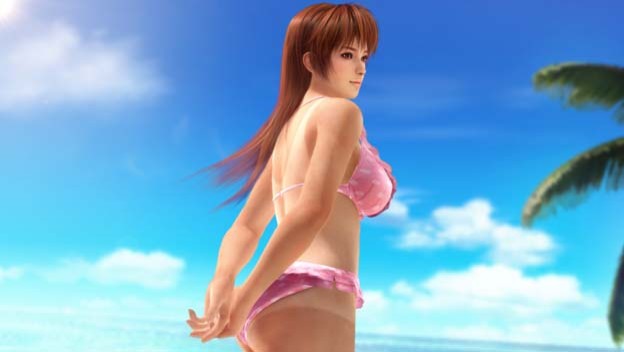Recently, I read some news about the new Dead or Alive Xtreme 3 featuring pole dancing, which helped me remember Koei Tecmo’s decision to not bring the game to the West. The publisher doesn’t wish to be criticized, and I suppose I can’t blame them for that because I know how critics like Jim Sterling will react to the game. In my opinion, though, this is a cowardly decision. However, I recently picked up Game Art by Matt Sainsbury, which features an interview with Team Ninja about the franchise, and the representative, Yosuke Hayashi, gave us some interesting information that, regardless of the offensive qualities of Dead or Alive , is worth considering.
Game Art is a compilation of feature interviews with 40 different game developers about the artistic decisions behind their work. Each one is complemented with sleek, glossy artwork. In short, Sainsbury’s illuminating interviews show that there’s a lot more behind each game than its mechanics, and Dead or Alive is no exception. Here are some of my takeaways from Sainsbury’s interview with Hayashi:
- Team Ninja was deliberate about the sexualization of its female characters, and prefers to think of it as edgy and humorous instead of exploitative.
- The Japanese do not share the West’s attitude towards sexualization of female protagonists in games.
- The Japanese have a different attitude towards violence and sex than the west; over here, we want violence in our media to be realistic and gritty; in the East, however, the Japanese prefer ridiculous, flowery fighting similar to dance choreography.
In other words, Japanese and Western cultures tend to have polar opposite opinions about offensive content found in art and entertainment. For instance, the developer explained that although they were unapologetic about their sexy characters, they also weren’t trying to alienate its audience. “Yes, the characters are sexy or cute, and we don’t deny the personality that we want to bring into the game. We were careful not to cross a line to the point where it would put people off.” (Sainsbury, 108)
Having watched Jim Sterling’s video about the topic, whose views are similar to most Western critics, I would say that Team Ninja failed that specific goal. In his 2012 video about Dead or Alive , Sterling criticized Team Ninja’s dismissal of criticism, citing that cultural expectations aren’t an excuse for such perverted imagery. He also went on that the age of the characters makes their mannequin-like features and anti-gravity boobs sickening, designed only to appeal to younger males.
I can see why the West has a hard time accepting Team Ninja’s attitude towards the girls, some of whom are below 18, but Dead or Alive is not the only game to be accused for being exploitative. I think this is a fairly common complaint Western audiences have towards Japanese games. Remember in one of the takeaways about how the Japanese prefer their violence hyper-stylized? Well, they apply this same approach to sexuality. Why did they do this? Because they wanted to create something humorous, something not to be taken seriously, which I imagine would be a lot more difficult to buy had Team Ninja created an island full of the most realistically rendered female characters. I would also suggest Team Ninja apply such ridiculous specifications to their male characters as well, but let’s face it: the company knows its audience too well .

I’ve been focusing on Dead or Alive this whole time, but I want to turn attention to the seemingly automatic, knee-jerk reaction to games with even a hint of sexualized imagery. Turns out Sainsbury and I share an appreciation for Lollipop Chainsaw – also featured in his book – which also met criticism for its sexualization of the main protagonist, Juliet Starling. Yes, she is a barely-legal teenager wearing a sexy cheerleading outfit, but she also wields a chainsaw, and her sidekick is her boyfriend, a once star Varsity athlete who has been reduced to a sentient head to be used as a tool per Juliet’s whim. Basically, the game is about gender role reversal, and while Juliet’s outfits are skimpy, she’s empowered and ready to chop off your grubby hands (or head) on a whim. Her looks are not exclusively for show, although I’m sure that helped the game sell approximately 1,000,000 copies.
Do I think Western critics are wrong to outright criticize the sexual content of Dead or Alive ? Not really. I can see the points Sterling and Sainsbury made in their respective arguments. On one hand, it does seem like Team Ninja caved to fan pressure to include bigger boobs in Dead or Alive 5 , and I’m not convinced (although I’m open to arguments) that Team Ninja is trying to reverse gender expectations like in Lollipop Chainsaw . On the other hand, I also buy Sainsbury’s argument about cultural differences and Team Ninja’s intent to create something edgy and humorous instead of merely exploitative (whether or not they succeeded, I’ll leave that to people who have actually played the games). Regardless, I think some games such as Lollipop Chainsaw are automatically mislabeled exploitative based on first impressions, so maybe we should take a step back and evaluate the hypersexualized imagery; find out if there’s a reason (other than for masturbatory purposes) for why it’s in games before jumping to outrage.
P.S. I highly recommend checking out Game Art by Matt Sainsbury, which you can purchase here .
